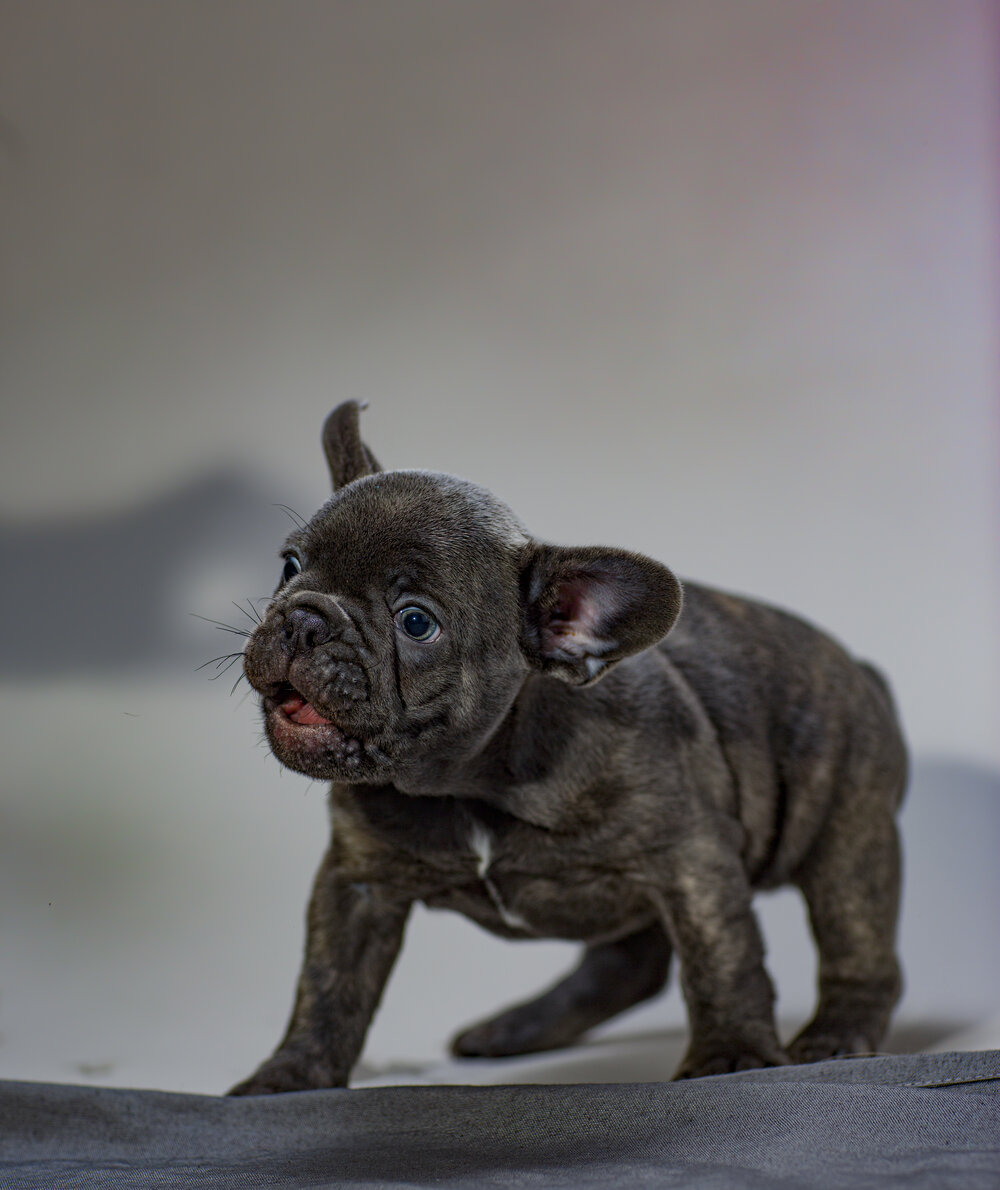French bulldogs are wonderful pups with lively personalities and adorable faces, but there are some Frenchies that have beautiful blue eyes that capture the hearts of those lucky enough to own the precious pups.
Read on to learn more about these adorable dogs and their baby blue eyes!
How Do French Bulldogs Have Blue Eyes?
Most, if not all, French bulldogs are born with blue eyes. In fact, most dog breeds do.
However, in rare occurrences, they maintain their blue eyes into adulthood.
Many French Bulldogs have eyes that change to grey or brown as they grow up, caused by higher melanin levels.
The blue eyes of the puppies will change after around ten weeks, then they will most commonly be the brown color. If, in fact, the blue eyes are retained, it is due to a rare gene that is normally accompanied by an equally rare fur color.
The gene that contributes to the highest potential for blue eyes in a French bulldog is the merle gene.
Another rare occurrence of blue eyes is present in albino Frenchies, though this is the rarest of possibilities.
10 Facts About Blue Eyed French Bulldogs
1. Health
Rare genes, such as blue eyes, in Frenchies, have been linked to certain health problems.
Blue-eyed Frenchies have been known to develop deafness, blindness, cataracts, and other sensory problems. In more severe cases, the pups can be born with only one eye or only one functional eye.
This can affect the overall health and wellbeing of your pup in the long run.
2. Risks
Potential risks for these pups include reddened eyes, blindness, deafness, and corneal ulcers.
They may also develop skin allergies. These can cause more severe health risks for your pup down the road, so make sure to take them for regular visits to the vet for their wellbeing.
3.The Types of French Bulldogs Have Blue Eyes
The most common types of French bulldogs are puppies, who eventually grow out of their eye color after around ten weeks.
Other types of Frenchies that can potentially have blue eyes are albinos, merle-gene carrying pups, and other Frenchies with gene anomalies.
4. The Cost of a Blue-Eyed French Bulldog
Frenchies with blue eyes are generally more pricy than ones with brown eyes due to the rarity of the blue-eyed gene.
However, it may be possible to get a blue-eyed pup at a lower price, as all the puppies will have blue eyes.
If your pup happens to have a genetic anomaly that carries into adulthood, you could discover that you have a lovely blue-eyed adult dog after about ten weeks.
This is rare, however, as many blue-eyed pups will already have a higher price due to their similarly rare fur coloring.
Pricing can be anywhere above a thousand dollars or two thousand, depending on the pup’s coat color and other factors.
5. Their Blue Eyes are Not Actually Blue!
You read that right. When dogs appear to have blue eyes, such as Frenchies, it is actually a scientific optical illusion.
Dogs with apparently blue eyes actually have no pigmentation in their irises.
The blue color comes from the light reflecting and scattering in their irises, giving the appearance of a blue color.
This causes many breeders and geneticists to conclude that no Frenchie has 100% blue eyes, but rather, they have non-pigmented eyes that appear blue.
6. The Temperament of a Blue-Eyed Frenchie
Most Frenchies have an expressive and playful nature, and they are very lovable. Frenchies also love to exercise and be active for a short period of time.
If your blue-eyed Frenchie has certain eye-related health issues, however, they may be more irritable or less playful, depending on their level of health and their overall wellbeing.
In most cases, these pups are incredibly affectionate and will love some pets and cuddles.
7. Breeding Your Blue-Eyed Frenchies
Generally, it is not a good idea to breed your blue-eyed Frenchies with other rare breeds, for this can heighten the risk of the babies developing more severe health issues in the future.
This is more heightened if the parents have preexisting conditions that can be passed on to the babies.
In order to ensure the safety of your pup and their future puppies, it is a good idea to leave the breeding to certified breeders to lower the risk of harming the pups’ health.
8. Frenchies Can Develop One Blue Eye and One Differently-Colored Eye
Yes. This is quite rare, but it is a phenomenon called heterochromia.
This means that your pup has two differently-colored eyes. It does not pose a risk to your pup if they had this dual-coloring at birth, but if your pup suddenly has a change of eye color in one eye, you may want to take your pup to the veterinarian.
It could be a sign of a serious health problem, so make sure to get your pup checked up to eliminate any doubt.
9. Where You Can Buy a Blue-Eyed Frenchie
The best place to purchase a blue-eyed Frenchie is a reputable breeder.
If you purchase from a breeder with a less-than-stellar track history, your pup could have a higher risk of health problems.
Good breeders will breed with health-specifics in mind, for these pups have a higher possibility of developing health issues such as blindness and deafness.
10. Is the Blue-Eyed Gene More Prominent in Male or Female Frenchies?
There is generally the same percentage of possibility for both male and female
Frenchies to have the blue-eyed gene. They can both carry this gene into adulthood.
The gender you choose to bring home is completely up to you, and either way, the pup will bring you love and joy for years to come!
In Conclusion
Frenchies are amazing, adorable dogs that have a lot to offer us. The rare blue-eyed Frenchie is one of the most expensive, but most beautiful, Frenchy you can find.
Look out for health problems, but as long as you take your pup to the vet often, they will live a long and happy life!
I hope this list has shown you just how special and wonderful these adorable pups can be!




